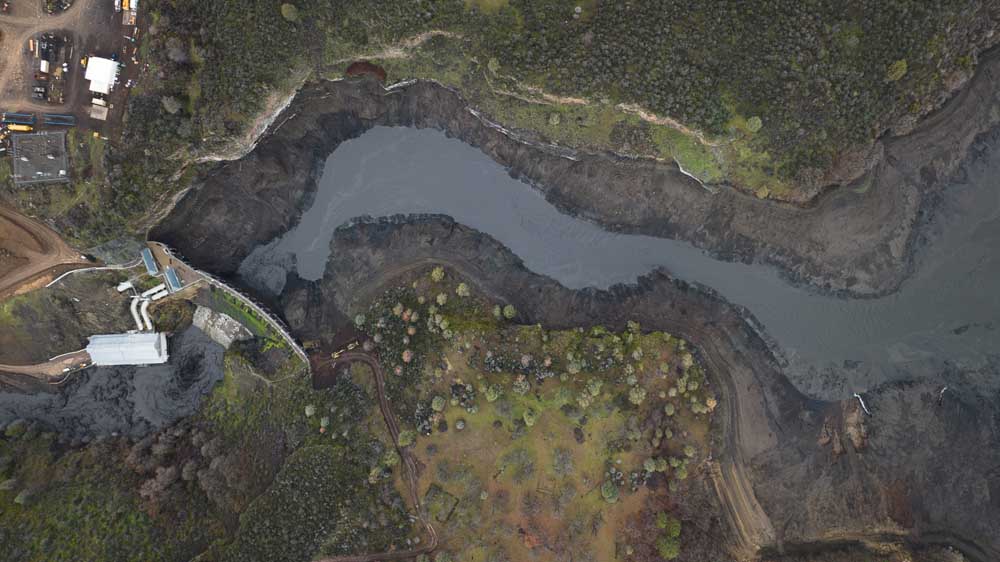Mud and depleted oxygen: Deer, fish die after Klamath River dam breaching
Published 5:30 pm Wednesday, January 31, 2024

- The dewatered reservoir behind Copco 1 near Hornbrook, California, can be seen in this photograph provided Wednesday by the Klamath River Renewal Corporation, which is removing the dam and three others on the Klamath River. Drawdown of the reservoir, which began Jan. 23, has sent silt downstream and killed a number of fish, while several deer have become stuck in muck and died.
The company removing four dams on the Klamath River to protect salmon and improve river health is reporting the death of significant numbers of non-native fish and an oxygen level of 0% on Saturday as reservoirs drained and silt washed downstream.
Meanwhile, the Hornbrook Fire Protection District is reporting the death of at least eight deer that became stuck in muck at the draining reservoirs.
One dam, Copco 2, was removed last year, with three to go, beginning with the “drawdown” of water in the three reservoirs behind the other dams. The drawdown began Jan. 11 at Iron Gate, Jan. 16 at JC Boyle and Jan. 23 at Copco 1 dams, all northeast of Hornbrook, California.
The Klamath River Renewal Corporation, which is removing the dams and overseeing restoration efforts, issued a written statement Wednesday, saying the impacts were expected.
“The Klamath River is experiencing a period of poor water quality as sediment is evacuated from the former reservoirs,” the statement read. “This short-term impact will be small, relative to the long-term improvements to water quality and fisheries habitat.”
The statement said fluctuations in silt levels are expected for months. Impacts are expected to be heavy for non-native fish and less for salmon.
“Significant numbers of non-native (introduced) fish, such as yellow perch, perished as reservoirs were drawn down,” according to the company statement. “Many non-native fish that do survive drawdown are not adapted to a natural river environment and are not expected to live. We can also expect some fish mortality downstream as the evacuation of sediment impairs water quality.”
The majority of salmon have avoided impacts because they overwinter primarily in tributaries and use the river’s main stem as a migratory corridor in the spring and fall, when conditions are expected to improve, according to the statement.
On Saturday evening, the river downstream of Iron Gate Dam — the most downstream dam slated for removal — “became depleted of oxygen for less than 24 hours” due to dead algae and fine sediment in the water, according to the company.
Requests for comment from the California Department of Fish and Wildlife were not immediately answered Wednesday.
Meanwhile, the Hornbrook Fire Protection District on Tuesday announced that it expected the arrival of specialized gear designed for mud rescues. District personnel on Sunday had worked with the California Department of Forestry and Fire Protection and the California Department of Fish and Wildlife in an attempt to rescue deer trapped in the mud at Mallard Cove in Copco Lake.
“Despite deploying our rescue trailer and making multiple attempts to reach the animals safely, Fish and Game made the difficult decision to euthanize them to prevent prolonged suffering,” the district announced in a written statement.
Calls for additional comment from district personnel were not immediately returned Wednesday.
The deer were drowning in mud, it was getting dark, and the decision was made to end their suffering before they wouldn’t be visible, according to district social media posts. The deer were stuck hundreds of feet from solid ground, well beyond the near-shore area.
“Hornbrook Fire procured flood, swift water, and animal rescue equipment ahead of the dam removal anticipating the new challenges we might face with the river, but crossing the La Brea Tar Pits was not what we expected,” according to the posts. “We thought we would be facing animals getting stuck in the mud much closer to the shoreline.”
During the rescue attempt, rescuers themselves were getting stuck.
“It’s crucial to inform the public that the current condition of the lake bed is unsafe for exploration, with deep and extremely dangerous mud,” the district urged.
After the deer losses, at least one local resident created water troughs out of plastic barrels cut in half so people could come get them, place them at strategic locations and fill them with water so wildlife would not have to cross the mud to get to drinking water, according to a community social media post.
Overall, the dam removals will expose about 2,200 acres of reservoir beds that will be restored over a multiyear process. Upwards of 17 billion seeds have been collected and will be planted.
The primary goal of the dam removals is to restore fish passage and improve water quality. The estimated cost of the dam removal and restoration is $450 million, with a $50 million contingency fund. The cost is funded through a $200 million surcharge on PacifiCorp and $250 million in bonds from the state of California.






